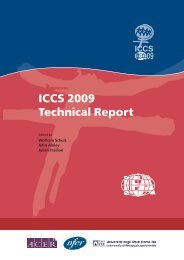Teacher Education and Development Study in Mathematics - IEA
Teacher Education and Development Study in Mathematics - IEA
Teacher Education and Development Study in Mathematics - IEA
Create successful ePaper yourself
Turn your PDF publications into a flip-book with our unique Google optimized e-Paper software.
154<br />
TEACHER PAY AND STUDENT MATHEMATICS ACHIEVEMENT<br />
<strong>Teacher</strong> salaries<br />
<strong>Teacher</strong>s <strong>in</strong> Switzerl<strong>and</strong> generally are paid accord<strong>in</strong>g to a salary scale that corresponds<br />
to the school level <strong>in</strong> which they teach <strong>and</strong> their <strong>in</strong>itial education. Advancement for an<br />
<strong>in</strong>dividual teacher occurs with<strong>in</strong> their <strong>in</strong>itial salary scale <strong>and</strong> typically depends only<br />
on years of service. The formal employer of teachers <strong>in</strong> Switzerl<strong>and</strong> is the canton or<br />
the commune (OECD, 2004a). Terms of employment, <strong>in</strong>clud<strong>in</strong>g the salary scale, is<br />
therefore determ<strong>in</strong>ed by one of the two. Also, teachers are not offered a lifetime contract,<br />
a practice that guards aga<strong>in</strong>st teachers becom<strong>in</strong>g complacent <strong>and</strong> motivates them to<br />
cont<strong>in</strong>uously improve their performance. In general, teachers’ salaries for a particular<br />
set of characteristics are set uniformly with<strong>in</strong> a canton, but there is considerable<br />
variation across cantons to reflect differences <strong>in</strong> number of lessons taught <strong>and</strong> costs of<br />
liv<strong>in</strong>g (OECD, 2004a).<br />
<strong>Teacher</strong>s’ work<strong>in</strong>g time is def<strong>in</strong>ed <strong>in</strong> terms of teach<strong>in</strong>g hours. These vary by canton,<br />
from 1,900 hours to 2,000 hours per year. On average, the hours are broken down as<br />
follows: classroom-based teach<strong>in</strong>g (50%), preparation (23%), plann<strong>in</strong>g <strong>and</strong> evaluation<br />
(11%), adm<strong>in</strong>istration <strong>and</strong> counsel<strong>in</strong>g (8%), <strong>and</strong> cont<strong>in</strong>u<strong>in</strong>g education <strong>and</strong> jo<strong>in</strong>t<br />
activities (8%) (OECD, 2004a).<br />
In the early 2000s, primary school teachers earned less than teachers at higher levels, but<br />
at $US35,059 per annum, their start<strong>in</strong>g salary was nevertheless the second highest among<br />
the commensurate salaries of all OECD countries. The start<strong>in</strong>g salaries of secondary<br />
teachers <strong>and</strong> upper-secondary teachers, which were $US41,358 <strong>and</strong> $US49,484,<br />
respectively, ranked the highest among the start<strong>in</strong>g salaries for teachers of all OECD<br />
countries except Luxembourg (OECD, 2004a). This situation had not changed by 2007<br />
(OECD, 2007).<br />
Some cantons, such as Zürich <strong>and</strong> St. Gallen, have moved away from seniority-based pay<br />
to pay based on performance. This development is a recent one. In both cantons, salary<br />
<strong>in</strong>crements are provided over a period of years rather than on the basis of annual reviews<br />
of work. In Zürich, the assessment <strong>in</strong>cludes classroom observation, an <strong>in</strong>terview with<br />
the teacher be<strong>in</strong>g evaluated, <strong>and</strong> a report describ<strong>in</strong>g his or her pedagogical approach.<br />
In St. Gallen, the assessment focuses on three skill areas: organization <strong>and</strong> delivery of<br />
lessons; <strong>in</strong>teractions with students, parents, <strong>and</strong> teachers; <strong>and</strong> participation <strong>in</strong> <strong>in</strong>-service<br />
professional development. Neither place emphasizes subject-specific merit pay.<br />
An analysis of salaries conducted early this decade <strong>and</strong> tak<strong>in</strong>g <strong>in</strong>to account hours of<br />
work, age, professional development, experience, geographic region, <strong>and</strong> gender, showed<br />
teachers’ salaries compar<strong>in</strong>g favorably with salaries <strong>in</strong> other professions (OECD, 2004a).<br />
<strong>Teacher</strong>s’ salaries <strong>in</strong> comparison to GDP per capita were high. At the lower-secondary<br />
level, for <strong>in</strong>stance, a comparison of the salaries of teachers who had been teach<strong>in</strong>g for 15<br />
years with GDP per capita placed Switzerl<strong>and</strong> <strong>in</strong> third place among 29 OECD countries.<br />
Pay <strong>in</strong> certa<strong>in</strong> sectors, such as f<strong>in</strong>ance <strong>and</strong> <strong>in</strong>surance, were higher, but <strong>in</strong> other sectors,<br />
such as wholesale <strong>and</strong> the retail trade, hospitality, health, <strong>and</strong> social work, pay levels<br />
were lower (OECD, 2004b). No differences <strong>in</strong> salary by gender were evident. However,<br />
because there are more male teachers than female teachers <strong>in</strong> the lower-secondary <strong>and</strong><br />
upper-secondary levels of the school system, <strong>and</strong> given that the pay is higher <strong>in</strong> these<br />
sectors of the education system than <strong>in</strong> the primary sector, the average male teacher is<br />
likely to earn more than his female counterpart.<br />
Tables 43 <strong>and</strong> 44 <strong>and</strong> Figures 58 to 61 show the median salaries of Swiss teachers<br />
compared to the salaries of Swiss mathematics-oriented professionals for two years,<br />
1996 <strong>and</strong> 2004.

















